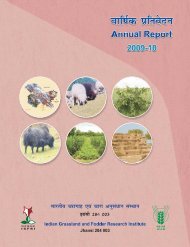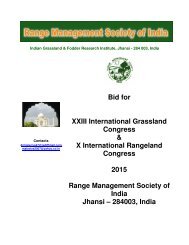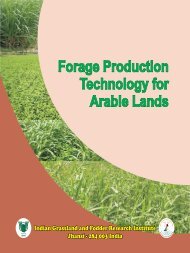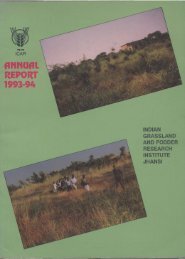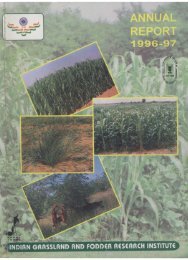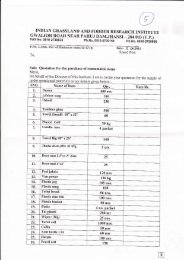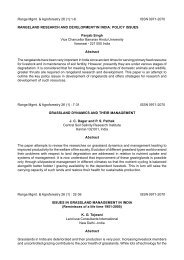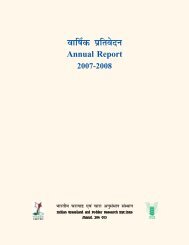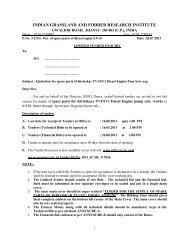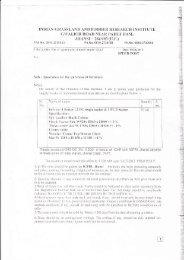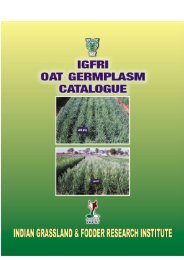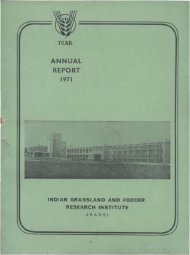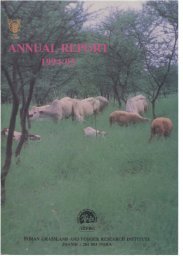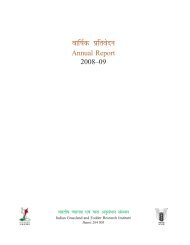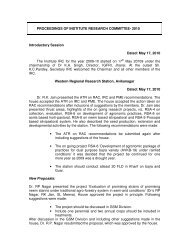IGFRI Vision 2050 - Indian Grassland and Fodder Research Institute ...
IGFRI Vision 2050 - Indian Grassland and Fodder Research Institute ...
IGFRI Vision 2050 - Indian Grassland and Fodder Research Institute ...
You also want an ePaper? Increase the reach of your titles
YUMPU automatically turns print PDFs into web optimized ePapers that Google loves.
<strong>Vision</strong> <strong>2050</strong><br />
*<br />
Table 2. Dem<strong>and</strong> <strong>and</strong> supply estimates of dry <strong>and</strong> green forages<br />
(million tonnes)<br />
Year Dem<strong>and</strong> Supply Deficit Deficit as %<br />
*Assumptions:<br />
Dry Green Dry Green Dry Green Dry Green<br />
2010 508.9 816.8 453.2 525.5 55.72 291.3 10.95 35.66<br />
2020 530.5 851.3 467.6 590.4 62.85 260.9 11.85 30.65<br />
2030 568.1 911.6 500.0 687.4 68.07 224.2 11.98 24.59<br />
2040 594.9 954.8 524.4 761.7 70.57 193.0 11.86 20.22<br />
<strong>2050</strong> 631.0 1012.7 547.7 826.0 83.27 186.6 13.20 18.43<br />
For calculation of dem<strong>and</strong> of dry <strong>and</strong> green forages, concentrate feed's data were<br />
adopted from article 'India's livestock feed dem<strong>and</strong>: Estimates <strong>and</strong> projections.<br />
Dikshit, AK, <strong>and</strong> PS Birthal. 2010. Agricultural Economics <strong>Research</strong> Review, 23(1):<br />
15-28'. Green forage, dry forage <strong>and</strong> concentrate feed were converted into dry matter<br />
(DM) applying a factor of 0.25, 0.90 <strong>and</strong> 0.90, respectively. Area under fodder crop <strong>and</strong><br />
pastures were extrapolated <strong>and</strong> divided into irrigated <strong>and</strong> un-irrigated areas. Supply of<br />
green fodder was calculated using a factor of 50 <strong>and</strong> 70 t/ha for unirrigated <strong>and</strong><br />
irrigated areas; For pasture sources, a factor of 1.2 to 1.5 t/ha was used for green<br />
forage supply.<br />
Table 3. Grazing resources in India<br />
Resources Area Percentage<br />
(million ha)<br />
Forests 69.41 22.70<br />
Permanent pastures, grazing l<strong>and</strong>s 10.90 3.60<br />
Cultivable wastel<strong>and</strong> 13.66 4.50<br />
Fallow l<strong>and</strong> 24.99 8.10<br />
Fallow l<strong>and</strong> other than current fallows 10.19 3.30<br />
Barren uncultivable wastel<strong>and</strong>s 19.26 6.30<br />
Total common property resources 54.01 17.70<br />
other than forests<br />
Sizeable amount of fodder dem<strong>and</strong> is fulfilled through vast grassl<strong>and</strong>s <strong>and</strong><br />
rangel<strong>and</strong>s (Table 3). Any positive or negative change in its position will have<br />
impact on several environmental issues. Hence, eco-friendly fodder<br />
production system is of prime importance. The dem<strong>and</strong> will reach to 1012<br />
million tonnes of green fodder <strong>and</strong> 631 million tonnes of dry forage by the year<br />
7



